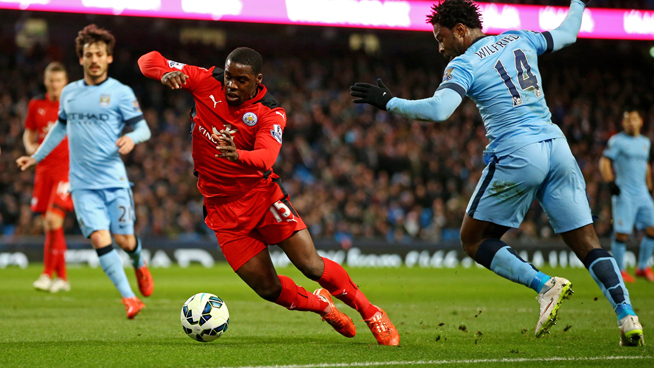Improve Soccer Agility with Lateral Strength Exercises

No sport, with the possible exception of track, is truly linear in nature, and soccer is no exception. Think about it: an attacker must avoid defenders by sprinting forward, quickly cutting from side to side and even moving backward when necessary. As a soccer player, you need to improve your strength in these positions if you’re going to perform at your maximum ability.
This presents a problem for most traditional strength programs, which overuse muscles in certain positions. Squats, Deadlifts, Bench Press, Overhead Press, Pull-Ups, Power Cleans, etc., are all great exercises, but they are all straight up-and-down movements (in the transverse plane). They completely neglect the lateral movements required in most sports, especially soccer.
This type of training limits your ability to produce force when moving in multiple directions and to make fast cuts to elude defenders. Also, when you are able to get into a position but cannot express any strength in that position, you’re more likely to get injured. Put simply, if you’re not developing the ability to get into good positions moving laterally and building the strength to move in and out of these positions, there’s a gap in your training, one that can seriously hurt your performance on the field.
RELATED: Improve Quickness With Lateral Speed Drills
Lateral Strength Exercises
Luckily, the fix here is pretty simple. Take your traditional strength program, which is already helping you get strong, and add some lateral movement assistance work. X-Band Walks, Lateral Lunges (both body weight and weighted), Cossack Squats, Slide Board Lateral Lunges and Lateral Jumps are some of my favorites.
Check out the videos below for demos (thanks to Dean Somerset and Eric Cressey for the Cossack Squat and Slide Board Lunge videos, respectively):
Programming
Beginners and soccer players who are new to lateral movements should program these exercises after their main lifts, as accessory movements for the lower body. A typical session might look something like this:
- A1. Vertical Jump – 2-3×6
- A2. Med Ball Throws – 2-3×6 each side
- B. Trap Bar Deadlift – 4×5
- C. DB Row – 3×8 each arm
- D. Lateral Lunge variation – 3×8 each leg
Once you get accustomed to lateral movements, you have more options. You can continue to use them as an accessory exercise and add an additional load, and/or you can use them as mobility drills to prepare for the heavy transverse plane lifting to come. Here’s a simple example of a movement prep circuit we would typically use to prepare soccer players for lateral movement.
- A1. Glute Bridge – 2×15
- A2. Side Plank – 2×15-30 seconds each side
- A3. Slide Board Lateral Lunge – 2×10
RELATED: How Duke Soccer Improves Agility
RECOMMENDED FOR YOU
MOST POPULAR
Improve Soccer Agility with Lateral Strength Exercises

No sport, with the possible exception of track, is truly linear in nature, and soccer is no exception. Think about it: an attacker must avoid defenders by sprinting forward, quickly cutting from side to side and even moving backward when necessary. As a soccer player, you need to improve your strength in these positions if you’re going to perform at your maximum ability.
This presents a problem for most traditional strength programs, which overuse muscles in certain positions. Squats, Deadlifts, Bench Press, Overhead Press, Pull-Ups, Power Cleans, etc., are all great exercises, but they are all straight up-and-down movements (in the transverse plane). They completely neglect the lateral movements required in most sports, especially soccer.
This type of training limits your ability to produce force when moving in multiple directions and to make fast cuts to elude defenders. Also, when you are able to get into a position but cannot express any strength in that position, you’re more likely to get injured. Put simply, if you’re not developing the ability to get into good positions moving laterally and building the strength to move in and out of these positions, there’s a gap in your training, one that can seriously hurt your performance on the field.
RELATED: Improve Quickness With Lateral Speed Drills
Lateral Strength Exercises
Luckily, the fix here is pretty simple. Take your traditional strength program, which is already helping you get strong, and add some lateral movement assistance work. X-Band Walks, Lateral Lunges (both body weight and weighted), Cossack Squats, Slide Board Lateral Lunges and Lateral Jumps are some of my favorites.
Check out the videos below for demos (thanks to Dean Somerset and Eric Cressey for the Cossack Squat and Slide Board Lunge videos, respectively):
Programming
Beginners and soccer players who are new to lateral movements should program these exercises after their main lifts, as accessory movements for the lower body. A typical session might look something like this:
- A1. Vertical Jump – 2-3×6
- A2. Med Ball Throws – 2-3×6 each side
- B. Trap Bar Deadlift – 4×5
- C. DB Row – 3×8 each arm
- D. Lateral Lunge variation – 3×8 each leg
Once you get accustomed to lateral movements, you have more options. You can continue to use them as an accessory exercise and add an additional load, and/or you can use them as mobility drills to prepare for the heavy transverse plane lifting to come. Here’s a simple example of a movement prep circuit we would typically use to prepare soccer players for lateral movement.
- A1. Glute Bridge – 2×15
- A2. Side Plank – 2×15-30 seconds each side
- A3. Slide Board Lateral Lunge – 2×10
RELATED: How Duke Soccer Improves Agility










